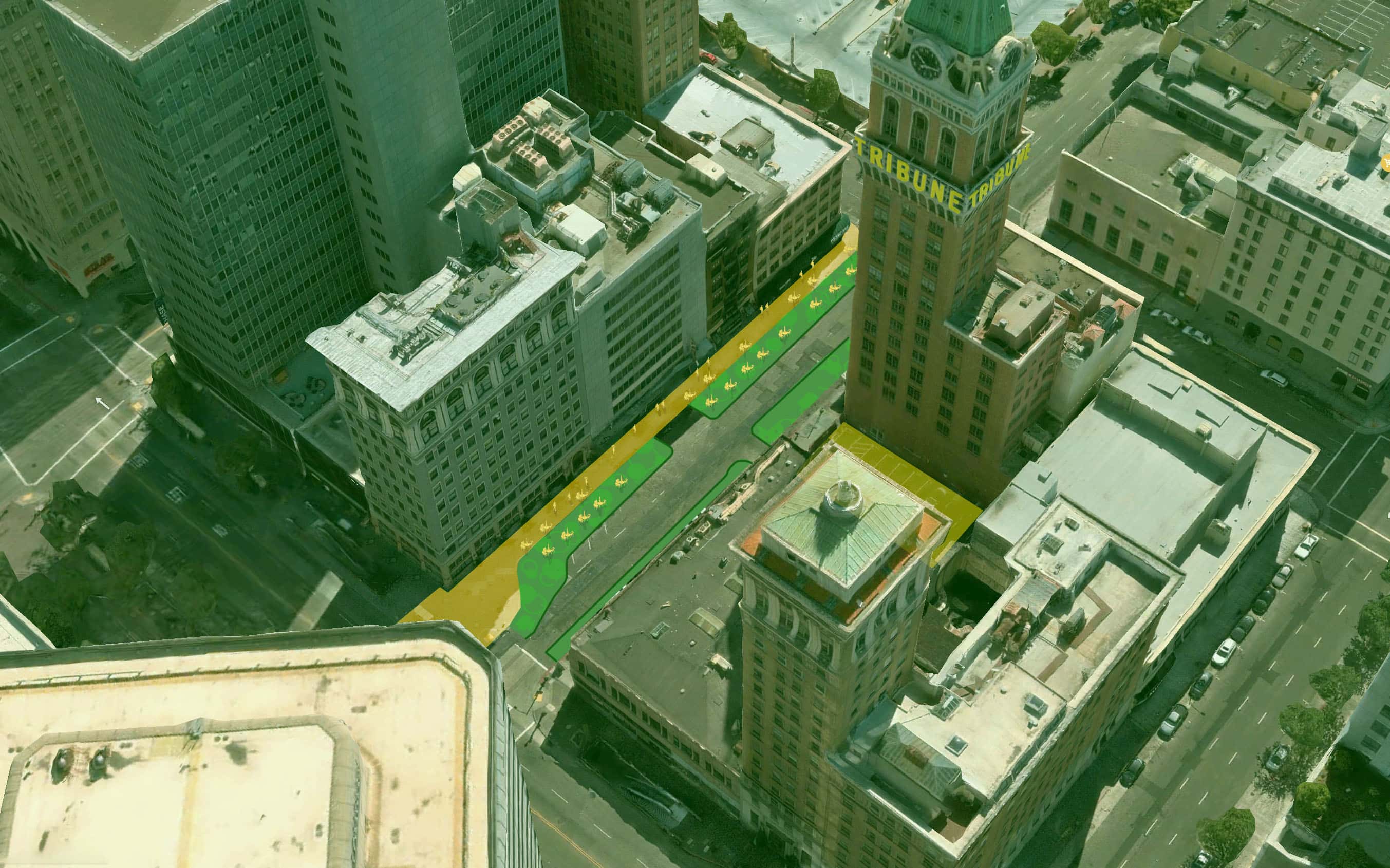This project was born in a spirit of hope.
As architects and designers, it is imperative to support Oakland in finding possible solutions for our community grappling with COVID-19. Specifically, Arcsine has been studying solutions that can be applied to a wide variety of public-facing businesses and neighborhoods. We want to bring people back to the streets of Oakland by activating sidewalks with outdoor dining, parklets with pedestrian and bicyclist-friendly access points, and other creative ways to re-purpose outdoor spaces, in a safe and thoughtful way.
We want to celebrate equality and ensure public spaces are accessible to all. This particular concept for Thirteenth Street is not meant to be a singular solution, in isolation. Rather, our hope is that ideas explored can be a part of the greater urban fabric. A kit of parts and ideas that can be adapted for use in many neighborhoods.
Creating a partnership of businesses in the streetscape can help find opportunity and relief through strength and diversity. Through re-imagining the street, the sidewalk, open lots, bike sharing stations and empty storefronts; we can design an ecosystem of support, community, and economic activity. To achieve these goals, it’s important to utilize as much available space as possible to balance the requirements of social distancing while providing opportunities.

While much of the focus here is on dining & seating, on assisting the brick and mortar storefronts on the street, we ultimately find the success in these streetscape interventions is found in the programming of the space. Good Mother Gallery, which sits within the heart of our programming here, has already begun some activation within the Oakland community. More importantly, they have also started conversations with other businesses on the street, namely Tribune Tavern, on what it would look like to bring bar service into the public domain.
As we look across Oakland for spaces that can accommodate this type of street intervention, we really feel the key is to have parking lots or flexible space that can accommodate this kind of diverse programming, as well as a variety of business types to help facilitate collaboration. This component fosters community and helps the activation of the streetscape transcend economic aims.
We are exploring opportunities for sidewalk level kiosks (see keynote 4) by ideating with local fabricators to develop and imagine these ‘kiosks’ as an opportunity for shared resources between businesses. Whether they are used for serving people on the street or for mobile takeout orders is up to the businesses involved, considering take away facilities have become a large part of many restaurant’s business models recently.
Like with Good Mother Gallery, who is creating programming at the parking lot space, we imagine uses extending beyond film screenings- like music or dance recitals. A place for children camps to provide summer performances in a safe, distanced area. Additionally, the site affords the vertical walls for artistic activation. BANDALOOP is exploring utilizing this space like they do at the Great Wall near Lukas Tavarn in Uptown.
Ultimately the sharing of resources becomes very important to this model.
Tables and chairs spill out into the space immediately adjacent to the restaurants but intentionally blur the lines between businesses – breaking the traditional “Parklet” model. It also bridges the street between multiple restaurants – as they do between Mocking Bird and Golden Lotus – and allows for flexibility for both the guests and the restaurants adapt to a new dining experience.
A storefront retail component is also incorporated within the larger outdoor intervention. Tech companies like Square have been working towards identifying spaces that could be curated as Shopable Moments for multiple retailers to combine the pleasure of window shopping with online shopping. We also see these windows as great locations for urban art projects, that would not only become smaller urban interventions but also create opportunities for artists and collaborators. Similar initiatives are being discussed with Art Murmur and galleries like Good Mother, to celebrate artists within shopfront installations. These too, can be equipped with a Venmo style purchase ability and support the art community hit by the pandemic.
As cities begin to open up, its crucial to look at how sidewalks and streets can be made safe and accessible for its users between different outdoor activities by monitoring vehicular traffic, using planters and other urban interventions to create safe zones for the community. It is also imperative to study the relationship between sidewalk, streets, parking lots, at individual streets like 13th Street, but also look at it a larger, urban level across the city as a renewed social-urban fabric.

We would like to reiterate that the Oakland community spirit is alive and well. It is clear that it has even grown during COVID-19 and the Black Lives Matter/Anti-Racism work. We are hopeful that design interventions like these support local businesses at the micro neighborhood level and with the right partnership and public engagement can be a small step toward addressing other important urbanist issues like the housing crisis, a bicycle city, and a community supporting artists.
Our call-to-action is that the City of Oakland select and support pockets around the city with slow and closed streets that can be activated like this proposal. We encourage active community members to take hold of these spaces to design and program activities.
This proposal is given in the spirit of an open-source-mindset and we hope that designers across town will work with their neighborhoods to develop additional interventions; celebrating the diversity of what makes our city so great.
A collection of these nodes will form a constellation of beautiful public spaces across Oakland – providing for a memorable summer – and leave us with a desire to ensure that the open use of our streets becomes a lasting positive aspect of this otherwise difficult time.



